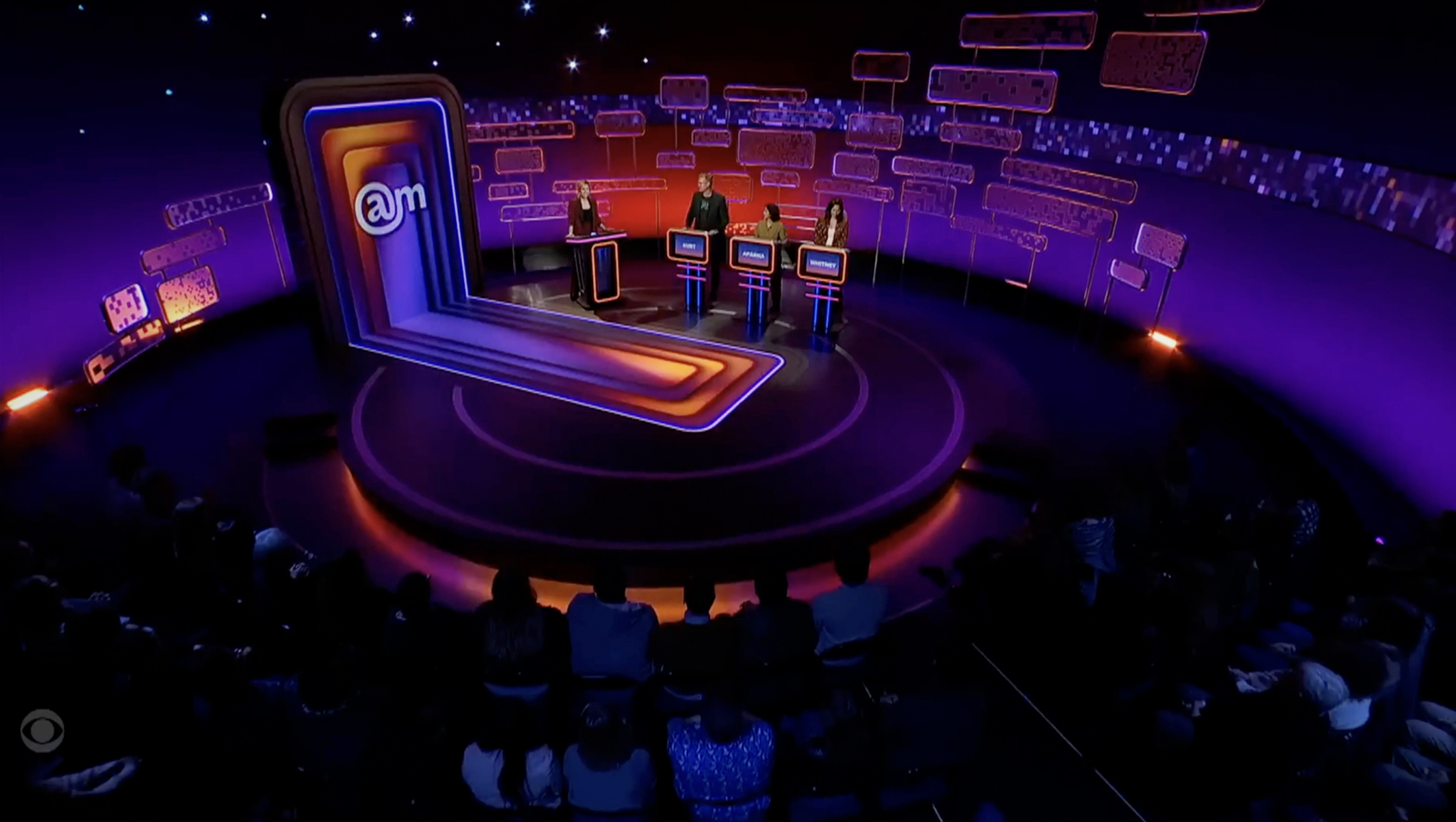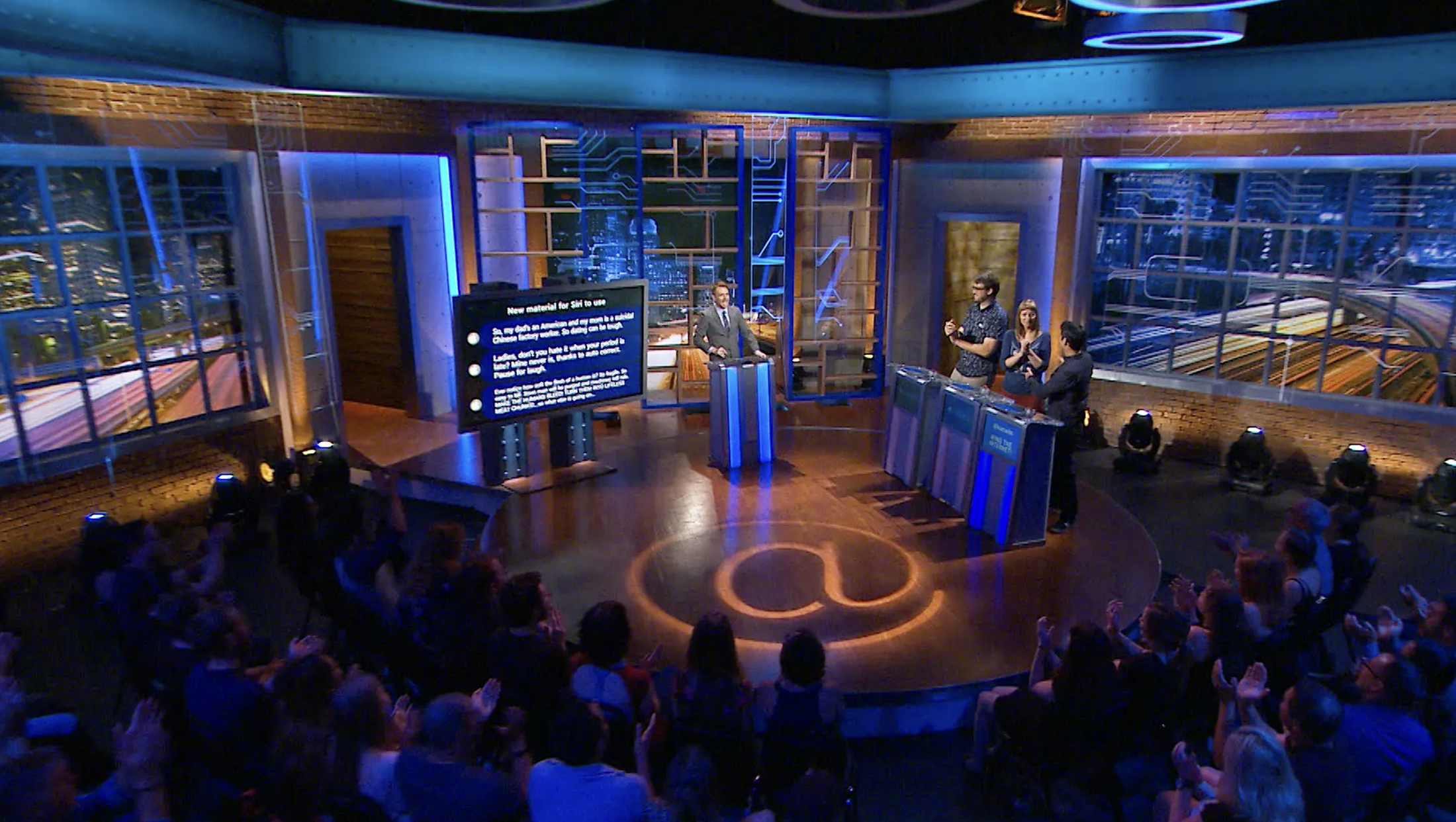‘After Midnight’ packs open set design with nods to the wild world of the web

Subscribe to NCS for the latest news, project case studies and product announcements in broadcast technology, creative design and engineering delivered to your inbox.
“After Midnight,” CBS’s comedy game show that serves as the replacement for “The Late Late Show” uses a set that leverages both technology and more traditional scenic elements to channel the notion of pixels and their role in the funny stuff the Internet spits out each day.

While the space is outfitted with an LED video wall that becomes part of the floor as well as a strip of LED video panels around the top, it notably lacks any structural walls, instead relying on a variety of floating elements.
Most of this includes panels with thick, pipe-like frames with supports sprouting from the floor of extending into the ceiling.
Inside the frames is a clear panel with a variety of grid-like pixel patterns that seem to be a nod to 8-bit video games and the Minecraft franchise.
All of those squares appear to serve as a reference to the notion of pixels or bits of data, which tie into the show’s theme of relying on the Internet memes, posts and other content for the basis of its questions.
Because the imagery on panels vary in scale, some also end up looking a bit like Tetris pieces, though the reference to gaming still works with the overall idea of the show’s use of the Internet zeitgeist.
Near the host position is a large seamless vertical LED array that allows the host to reference imagery related to the game. The installation is tall and narrow and then wraps around into the circular riser’s floor, a feature that allows guest contestants to interact with it by standing on either side of a divided graphic.

Comedian contestants stand behind small lecterns with a video screen serving to display current scores.
Because, with the exception of the LED panel, the set lacks any structural walls and instead relies on the suspended panels and the large, hockey-puck like riser to demark its footprint.

The on-camera space is wrapped with a cyc that is, like other elements of the set, flooded with colored lighting cues that change throughout the show, including the ability to add pops of different colors in key locations.
The video wall element and background frames all feature rounded corners, giving them similarities to smart devices and app icons, while the way the LED floor tiles poke into the circular riser suggests the shape of the universal “on” or “power” symbol. The riser itself also feels a bit like an oversized button.
The original show, hosted by Chris Hardwick and aired on Comedy Central, was titled “@midnight” (read as “at midnight”). CBS changed the name to reflect the fact that the show doesn’t actually air at midnight (it starts at 12:37 a.m. eastern), but still uses the “@” symbol in the logo.
Alternatively, the show is also identified using an “@m” icon that ends up double duty as an abbreviation of the show’s name and a reference to “a.m,” which stands for “ante meridiem.” That, in turn, translates to “before midday” and is commonly used in locales that use 12-hour time to indicate that a time is in the morning, including very early morning hours such as the show’s airtime.

The 2024 version of the show uses a significant different approach to its set than the Hardwick version, which relied on a large single video panel for gameplay.
Contestants stood behind more traditional lecterns and the set was wrapped in scenic walls with simulated brick and windows in front of printed duratrans graphics.
That version of the show did use an etched glass look to simulate the feel of oversized circuit boards, a common motif in set design of the day. The new version’s use of boxy pixels is a nice evolution to this theme and the interconnectivity of the 2024 version’s frames are in, many ways, a sort of slightly more sophisticated take on circuitry.
The new show’s LED ribbon adds an additional layer of flexibility by allowing it to display still and animated imagery based on the theme of the show or segment, as well as a default look speckled with square pixel-like patterns.
Subscribe to NCS for the latest news, project case studies and product announcements in broadcast technology, creative design and engineering delivered to your inbox.





tags
After Midnight, CBS, the late late show
categories
Broadcast Design, Broadcast Industry News, Game Show Set Design, Heroes